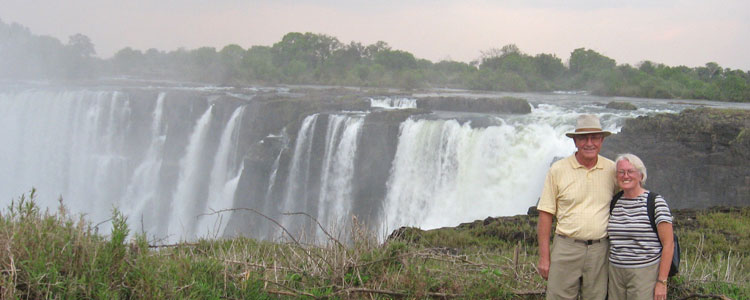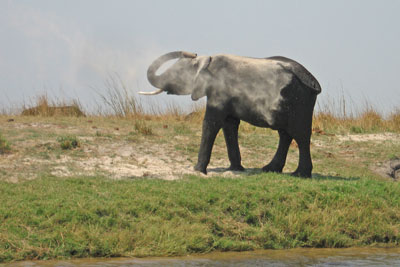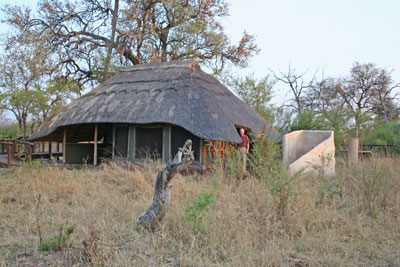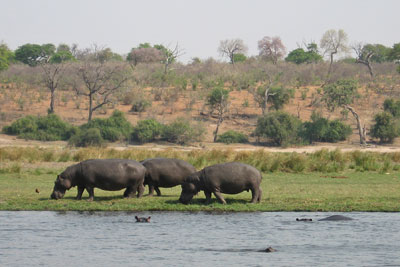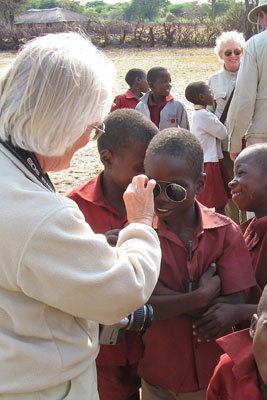Ultimate Africa – going beyond the simple safari in Botswana, Namibia and Zimbabwe
by Wanda Bahde, Summerfield, FL
For years, my husband, Ray, and I debated whether or not we should take Overseas Adventure Travel’s “Ultimate Africa” tour to Botswana, Namibia and Zimbabwe.
Acquaintances who’d already taken the tour either raved that it was the best or warned that we’d be disappointed with the fewer animal sightings. We vividly recalled wildebeest migrations in Eastern Africa’s Kenya and Tanzania as a favorite travel memory.
Negative news reports about Zimbabwe’s political situation and a cholera epidemic compounded our quandary. Should we go?
We finally booked OAT’s “Ultimate Africa” land-only package for Sept. 17-Oct. 5, 2009. Upon advice of South African friends, we opted to not take OAT’s pre-trip to Kruger because the region included was “too visited,” and we also chose to skip the post-trip to Cape Town.
Beginning in Johannesburg
We flew independently on Delta from Orlando to Atlanta and then nonstop to Johannesburg rather than accept OAT’s air routing from Orlando to Atlanta to London (Heathrow) and, finally, Johannesburg. Consequently, we arrived in Johannesburg at 5:10 p.m. on Sept. 18 rather than 9:30 a.m. on the 20th.
From the airport, we caught a free shuttle to the Peermont Metcourt Hotel (phone +27 [0] 11 928 1000, www.peermont.com), part of the Emperors Palace casino complex adjacent to the airport. Our superior king room was compact but adequate and included a full buffet breakfast for two for $176. Our second night at the hotel was included in our OAT land package.
In Johannesburg, my former colleague Bernard Spong gave us a personal tour, paying special attention to their Soweto. Soweto was established in the 1930s as a dormitory community for Johannesburg’s maids, gardeners and miners. Today its population is estimated at over 1.5 million.
Bernard went to South Africa in 1963 as a missionary and ultimately became a leader in the South African Council of Churches while personally experiencing South African struggles against apartheid. During our tour, Bernard shared his experiences, some documented in his autobiography, “Sticking Around.”
Most memorable — Bernard recalled how on the morning of June 16, 1976, he greeted members of his Bridgman Centre youth group as they happily passed by en route to join other schoolchildren in a peaceful protest against the enforced use of Afrikaans, the language of Dutch colonizers, in schools. He never anticipated the bloodshed that would occur. The shooting began and young Hector Pieterson and nearly 600 others died in the continuing riots; thousands more were wounded.
During the initial attack, children sought refuge at the Regina Mundi Roman Catholic Church. Its white marble altar was broken as students fled from the police. Bullet holes still riddle the church walls. Inside Regina Mundi, Larry Scully’s painting “Madonna and Child of Soweto” graces the sanctuary, and a historical photo exhibit, “The Story of Soweto,” hangs upstairs.
Johannesburg is a city rife with crime. Consequently, Bernard advised against touring without an organized tour or private car and driver. The city has no reliable public transportation system or taxi service, so it’s best to arrange cars through your hotel. Also, he warned me to leave valuables locked in our hotel and to keep my travel purse and camera on the car floor behind my legs to avoid smash-and-grab theft.
Safari life
With a hearty laugh and booming voice, guide Lloyd Mushure gathered our group of 15 at the Victoria Falls Airport and our safari officially began.
We spent the next 12 nights in private safari camps subcontracted by Wilderness Safaris (www.wilderness-safaris.com). Although each camp — Baobab Safari Lodge near Chobe, Lianshulu Lodge in Namibia, Wilderness Tented Camp in the Okavango Delta and Linkwasha Tented Camp in Hwange — had its own personality, all included open pole lodges for meals, drinks and talks. Individual cabins included en suite flush toilets and showers.
Generators powered lights and battery chargers between 5:30 a.m. and 11 p.m. while we were in camp. Solar panels provided hot water.
Because we were in malaria regions, each cabin was equipped with a can of Doom to kill bugs, Peaceful Sleep to repel bugs and a mosquito coil. Mosquito nets draped our beds.
Since camps were not enclosed by fences or any other protection from wildlife, we were free to walk vigilantly between cabins and the lodge during daylight but had to be escorted by a guide after dark. Each cabin had a Supersound air horn for emergencies; however, camp staff emphasized that an animal outside the cabin did not constitute an emergency!
Wildlife sounds — screeching baboons, croaking bullfrogs, howling hyenas — pierced the dark of night, but best were the ripping sounds from two elephants snacking on twigs from the tree adjacent to our platform tent. As we peered out the tent window, we were face to face with an elephant! Another night, an enormous hippo slogged out of the Delta marsh and sauntered past our tent en route to graze behind us.
Soon we became accustomed to the pace of safari days — mellow drumming and a gentle “Good morning” to wake us around 5:30 a.m. followed by a light breakfast and morning game drive; brunch and a “sleep safari” midday; afternoon tea with a talk before an afternoon game safari with sundowner drinks; evening dinner, and return to our cabins before lights out.
On safari, we saw a variety of animals but not the multitudes we had experienced in Kenya and Tanzania. Favorite sightings included a lioness with a zebra kill surrounded by vultures awaiting their turn, elephants using sand as talcum powder and sunscreen, and warthogs digging.
Our guides proved to be treasures of information. For example, we learned that, usually, hippos feed at night, consuming up to 132 pounds of grass each night; however, on the “Chobe River Cruise” (OAT optional, $45 per person), we watched them graze and swim midday. Hippos are extremely aggressive and in Southern Africa kill more people than do any other animals, especially during the early morning when people walk between them and their security of the water.
Most frightening was when our driver erroneously got between a mother elephant with a baby and the rest of the herd as they crossed the “road.” The mother and baby raced past, but then two adolescent males decided to get macho by flapping their ears and trumpeting before charging our Land Rover — right toward Ray. Luckily, it was a mock charge, the elephants stopping within a few yards of us. That was terrifying!
Afterward, our guide explained that we had to stand our ground or the elephants would have chased us.
Educational endeavors
In addition to taking game drives, we were introduced to the local history, issues and character of each area. During meals, camp staff and our guide joined us for informal conversation. We met local people in villages and schools, and every camp presented a “culture night.”
In Botswana, we mimicked the rigid Tswana village social structure at a celebratory feast. After dancing, the women served the men a meal of seswaa (pounded meat cooked in a three-legged cast-iron pot), mealie meal (pounded white cornmeal cooked slowly, like hot cereal), corn, squash and beans.
We also had mind-stretching discussions about how officials are trying to cull the elephant population before all life — plant and animal — starves and how the animal rights people are hindering their efforts. We discussed how the AIDS epidemic is spreading and the efforts taken to reduce it. We heard from blacks in Zimbabwe who wanted access to their land and from whites whose families had farmed that land since 1920 before being forcibly expelled under Mugabe’s land reform program.
Our flights between camps revealed landscapes that looked like abstract art. We saw stark contrasts between the lush Chobe floodplain and the arid Kalahari Desert. Over the Okavango Delta we spotted the hippo paths through the floodplains, and over the Kalahari we saw spoke-like paths around dried water holes. In Zimbabwe we saw patterns of the now-abandoned plantations. From the air, we also saw herds of elephants and, on occasion, had to avert landing until the landing strip cleared of warthogs or zebras.
Lloyd’s vast knowledge and experience coupled with good humor and positive attitude added to our experience. Thanks to him, our standard everyday phrases became “I’m brilliant!,” “Life is good!” and “TIA!” (“This is Africa!”).
On our last evening in Hwange, a round, decorated birthday cake was presented to one member of our group. He blew out the candles and tried to cut it. He stood up and literally stabbed it. Then he hollered, “It’s dung!” and reached for his flashlight.
Sure enough, it was a dried-elephant-dung cake — with essence of vanilla to hide the smell — frosted and decorated. A fitting conclusion to our safari days!
Victoria Falls
The comfortable Ilala Lodge (phone +27 [0] 21 683 6576, www.ilalalodge.com), located in Zimbabwe only 15 minutes from Victoria Falls, became home for our final two nights (twin from $170 per person, with buffet breakfast). We luxuriated in hot showers and thick towels before I fluffed with the hair dryer and Ray shaved with adequate light. The small conveniences we take for granted!
After quickly checking world news via satellite TV, we headed out to explore. The hotel restaurant featured tasty entrées, including crocodile kebabs ($12), warthog fillets ($18) and sirloin steak ($15). I recommend the warthog fillets.
When I asked about the “smoke” nearby, I learned it was the spray from the falls.
As a popular tourist destination, Victoria Falls boasts activities for nearly every interest. We started our explorations by visiting Mosi-oa-Tunya National Park, home to one-half of Victoria Falls (entrance fee, $20 per person for foreign visitors).
Straddling the border between Zimbabwe and Zambia, Victoria Falls is 355 feet high and a mile wide. Although this was the dry season, the thunder of the falls could be not only heard but felt!
We hiked the footpath facing the falls. The vantage points were spectacular.
Because the falls send clouds of spray high into the air to “rain” down, the area is surrounded by rich rainforest. Not only did we see rainbows, but, as the sun set, the mood of the falls became colorfully magical. However, because of this spray, I needed a plastic bag to protect my camera.
“On sights as beautiful as this, angels in their flight must have gazed,” wrote Livingstone.
We took the 13-minute “Flight of Angels” helicopter excursion over the falls and surrounding areas to see the angels’ view. The contrasts between the flat bush, the broad islanded headwater, the stark crevices and the powerful falls made it look like a science fiction movie set.
We recommend this experience (OAT optional tour, $115 per person); however, beware that the helicopters do use middle jump seats, so scurry to get a window seat so you’re not disappointed.
The stately, colonial Victoria Falls Hotel (www.victoriafallshotel.com) showed us a world of luxury. Opened in 1904, this hotel operated a private trolley service between the hotel and the Victoria Falls bridge and boathouse. From the hotel gardens, we took our final views of the magnificent falls.
Practical matters
We selected September for our trip because it was the end of the dry season, when more animals would be congregating around water holes. Although the temperatures should have been moderate, we found them warm, in the 90s at midday (and we’re Floridians!). The Okavango Delta was still flooded, but Victoria Falls was relatively sparse.
The Africa Adventure Company’s website (www.africa-adventure.com/places) provides useful general descriptions of area parks, complete with maps and “Best Time to Go” charts.
Cash was used in all camps for tips and settling accounts. Each camp used common tip boxes, one for camp staff and another for driver guides. Other than in Johannesburg, we used US dollars everywhere and found no need to convert currency.
Except for tips and souvenirs, we hardly used any cash. ATMs were available in Johannesburg and Victoria Falls. We paid for OAT optional tours with credit cards.
During safaris, we each were limited to one duffel weighing a total of 26 pounds. This included the weight of binoculars, camera gear and shoes. When not on safari, we each tucked the smaller OAT safari duffel into a larger wheeled duffel. Upon arrival at Victoria Falls airport, we simply pulled out the safari duffels and left the larger bags with extra clothing — and space for souvenirs — in storage at the Ilala Hotel.
During safari, we each took two pairs of zip-off pants and a pair of shorts and slacks plus lightweight shirts. I wore socks and hiking boots nearly all the time, even in the evening to protect from the sand and bugs. We needed fleece jackets for the cool mornings. Camps provided ponchos and umbrellas when needed.
We needed shower shoes, since some cabin and shower floors were slimy. Camps provided laundry powder for doing our “smalls,” and camp staff laundered outerwear and socks. I opted to wash my own knit tops after one came back with a hole. One person in our group required medical care for allergies either from the laundry soap or lack of thorough rinsing.
In the camps, we kept small items zipped in our bags to discourage bugs and geckos. To prevent malaria, we took Malarone. OAT provided refillable water bottles. Small flashlights were essential.
Each camp provided battery-charging stations either in our own cabins or at a common charging station. The three-rectangle prong adapter and the two-prong round adapter were necessary. Voltage was 220.
As for souvenirs, we found the best to be in Zimbabwe’s Ngamo Village. Prices were reasonable and the quality good. Also, we got some carvings at Linkwasha Tented Camp in Hwange. Otherwise, the best shopping was in Victoria Falls, either along the main street or in the craft market near Elephant’s Walk shopping center. Nearly everything was negotiable for cash or in trade for used clothing. Offer no more than one-third the asking price or start below what you’re willing to pay.
Afrizim’s company website (www.afrizim.com/travel_guides/animals) provides superb descriptions, data and images of wildlife seen on safari.
Peter Godwin’s memoir, “When a Crocodile Eats the Sun,” helped me understand the political situation in Zimbabwe.
Final analysis
Our total cost for the 19-day trip was $16,757, including $2,366 for round-trip air, $12,130 for the OAT land package with fees, $989 for Travel Guard insurance, $345 for optional tours, $150 for Zimbabwe double-entry visas direct from the embassy (www.zimbabwe-embassy.us), $177 for the Peermont Metcourt Hotel stay and approximately $600 for tips.
Are we glad we went? Yes! This trip proved to be more than just a safari. It was mind stretching. However, we would still urge first-time African safari travelers to go to Kenya and Tanzania, specifically to the Maasai Mara, Amboseli, Tarangire, Ngorongoro and the Serengeti, during migration seasons.
Nickie Fouché, the founder of AfricaTours (Amityville, NY; 800/235-3692, www.africasafaris.com), organized the “Kenya & Tanzania Horizons — Scheduled Safari” for us 10 years ago. While they no longer offer that particular tour, their 18-day "Best of Kenya and Tanzania" program (starting at $8,755, land only) covers the areas I recommended above.
Friends who took the 19-day “Best of Kenya and Tanzania” with Overseas Adventure Travel in October ’09 recommended their experience also ($5,245 base price, including air from New York, plus $1,295 for the Maasai Mara).
For those who have already experienced the thrill of animal migrations in East Africa, we recommend “Ultimate Africa” with Overseas Adventure Travel (Cambridge, MA; 800/955-1925, www.oattravel.com). Instead of just an animal safari, our experiences proved broader and more intense. It was much more than just a vacation!

